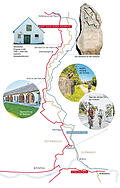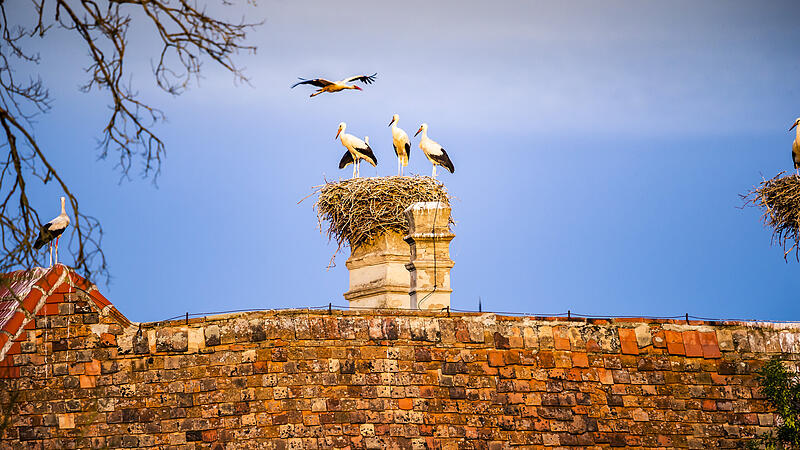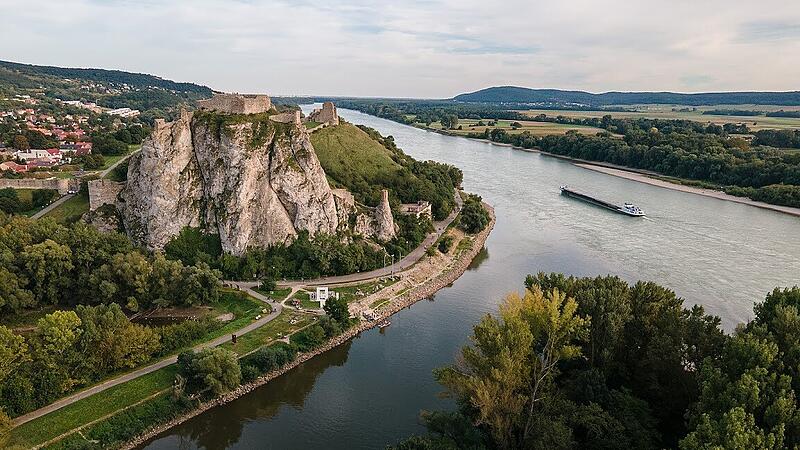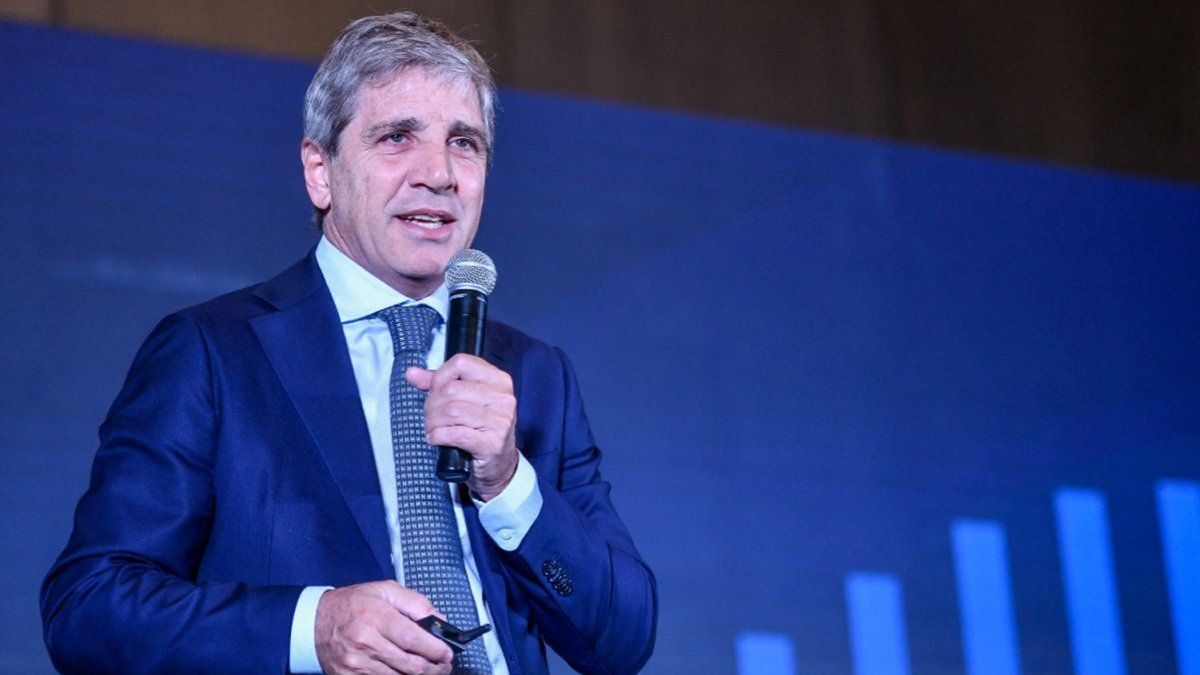There is a lot of landscape here, in the Marchfeld. And more vegetables. The soil in the Marchfeld is not only extremely fertile, but also historical. Because here, between Dürnkrut and Jederspeigen, the Habsburgs finally rose to power in the Battle of the Marchfeld, which came to an end centuries later further south. No less historically charged is the route along which we will connect these points with our e-bikes over the next three days – on the cycle path along the former Iron Curtain.
Our tour begins in the idyllic village of Hohenau, which lies next to the March in the border triangle of Austria, Czech Republic and Slovakia. Up until the late 1980s, fox and hare said good night to each other here, where the Iron Curtain was covered with a patina of uneasiness. Today Fox and Master Lamp have been happily frolicking back and forth between countries for a long time. As do we, a group of journalists from these three countries. Let’s go …
Day 1, Hohenau – Grub: We get up with the chickens and meet at the March-Thaya Center in Hohenau, where we mount the bikes. It’s only a few meters that we ride along the Kamp-Thaya-March-Radroute (KTM-Weg), and the signs of civilization are already behind us – except for wide fields of potatoes, from which a small wooden building with the inscription “Ringing Station” protrudes . Here the behavior of migratory birds is researched.
Download to the article


Kamp-Thaya-March cycle route
PDF file from May 13, 2022 (4.08 MBytes.)
Open PDF
We move quickly from there until we come to a pine grove that goes back to Maria Theresia. She once wanted to prevent the alluvial sand from being blown away and had trees planted on it. This is the first trace of the monarchy, and many more will follow. But first we visit the cellar lane in Sierndorf, one of 1100 cellar lanes in the Weinviertel. Leopoldine Rauscher welcomes us in a Kalmuck dirndl and with homemade nut strudel and grape juice. The cellar lane guide takes us through the two-kilometer-long cellar lane, which is lined with 113 wine cellars.
The wine cellars, that’s one thing. Today hardly anyone presses wine in it, modern press houses have made them obsolete. They are used for tranquility, sometimes as a lumber room and are often a mortgage for the heirs of the fourth or fifth generation, who often live far away. Because they have to be kept in good condition so that none of the dozens of meters deep cellar tubes collapse – and they have to be ventilated. “Often the owners don’t live in the village anymore, but they still bear responsibility for the cellar in the terrace above it,” says Leopoldine Rauscher, who obviously cares about the cellar lane culture.
The fact that there are so many cellars in the Weinviertel – 40,000 – is also a monarchical trace. It leads back to Emperor Joseph II, who abolished serfdom in 1782. Until then, only the authorities – church and rulers – were allowed to produce wine, but from now on the farmers were also able to press wine. Because they mostly also ran a farm in the Marchfeld, the cellar facades also differ from those in the rest of the Weinviertel. This becomes visible in the hayloft windows under the gable, in which the feed for the animals was stored, which is not available elsewhere.
Fodder, a good keyword, because hunger drives us on to Jederspeigen Castle, a pearl museum in which the history of the Habsburgs is unrolled. Beginning with the death of Frederick II in 1246 and the accompanying end of the 270-year-long Babenberg era. Bohemian King Ottokar II Premysl filled the resulting power vacuum, but his influence was quickly too great for the electors of the Holy Roman Empire. They surprisingly elected Rudolf I, who came from today’s Switzerland and was thought to be tractable, as the new Roman-German king in 1273 and ended the interregnum, the period of interim government. But Ottokar did not recognize the election, and there was a battle on the Marchfeld in which Rudolf I defeated the Bohemian king in 1278 – thanks to the help of the Hungarians. In the turmoil of the battle, Ottokar was murdered. It was the beginning of the Habsburg monarchy and – to put the Bohemians in a mild mood – their marriage policy.
After lunch in the castle (only on reservation, no regular guest operation) we enjoy regional wines, the Grüner Veltliner DAC and the Habsburg wine, an interpretation of the Grüner Veltliner. In general, the winegrowers are grappling with new ideas, because, according to winegrower Michael Müllner, “climate change is noticeable, the Grüner Veltliner is also affected, many are switching to red wine”.
Just impermanence. We also see a symbol of this at our next brief stop, the memorial to the Battle of Marchfeld. It is almost insignificant next to the main road – and yet it could be called the cradle of the Habsburgs. One of the most terrible battles was fought on today’s fertile soil. Structures of a possible mass grave of fallen knights were only recently discovered here using radar.
The day progresses and we cycle towards the end to Grub, where we find accommodation in the Küssler winery. The resourceful vintner offers wine tastings with a hearty Heurigen snack in the old ice cellar with a magnificent vault – as well as accommodation in wine barrel beds.
Day 2, Grub – Marchegg: The chickens have been awake a lot longer than we have today. After breakfast we cycle all the faster to Angern, where we board the ferry across the Morava to Slovakia. The March is just 60 meters wide here, 60 meters that millions of people were insurmountable for a long time. For someone who grew up near the border with what was then Czechoslovakia, it is always a limitless joy to be able to cross this border so easily. We switch to the “Iron Curtain Trail”, which leads through an idyllic wetland area that couldn’t be more original. Sometimes we drive on gravel roads, but mostly on an asphalt path, which the roots growing underneath give the impression of being permeated by veins. These paths were laid out for the military during the Cold War – so to speak, they were already veins at that time, through which the military was moved to guard the border in the bunkers that still exist today. Bunkers, which today serve graffiti painters as underground and tourists sometimes as photo motifs, sometimes as rubbish bins.
At Marchegg we cross again. The cycle bridge, which opened just last week, not only testifies to the growing together of the regions, but also to the widespread understanding that cycle tourism has long served as a driving force on both sides of the March.


The Lower Austrian state exhibition “Marchfeld Secrets – Man.Culture.Nature” is currently taking place in Marchegg Castle, which King Ottokar II had built to protect him from the Hungarians. This looks back on the first traces of people in the region. But it’s not so much the people who inspire, but rather the 50 pairs of storks that breed in the castle and the surrounding trees. These days the young hatch, while father Adebar lets himself be carried up by the thermals and goes in search of food in the wetlands of both countries. “The storks weigh one and a half kilos, they are as light as a paper plane, so they quickly gain height,” says Andreas Pataki, Managing Director of Schloss-Marchegg, who can hardly hide his fascination with flora and fauna.
The clattering of the storks can still be heard until mid-August, the young have time to master the thermals and then they sail to Africa – the young will not come back for two years, when they are sexually mature. So they don’t get eaten in the savannah.
We now cheat a little, park our bikes here and let a taxi drive us to Obersiebenbrunn, where we move into our quarters. Although the Marchland Canal cycle path also passes here, the turn is further south, at Schloss Hof, which we won’t get to until tomorrow. Our taxi stops briefly at the Storchenbräu in Untersiebenbrunn. Beer is also brewed in the Weinviertel.


Day 3, Marchegg – Eckartsau Castle: We have breakfast in Bauer’s guest house and take the picnic baskets we ordered with us, which we mount on the bikes in Marchegg. Then we cross the bridge again and cycle leisurely on the Slovak side to the ruins of Theben near Bratislava, which tower imposingly on a mountain. Below, the March flows into the Danube. But the March seems as if it doesn’t want to leave its dreamy river bed and flow into the hectically passing Danube. It almost seems as if she would stop. Perhaps she also does this to pause for a moment at the monument. It is dedicated to those who were shot trying to escape across what was then the Iron Curtain border. The patina of discomfort was no accident.
How euphonious is the name of the bridge over which we are now riding – having cycled back a bit: the Bridge of Freedom. It leads us straight to Hof Castle, which we leave on the right and cycle in the direction of the Danube, where the KTM path joins the Danube Cycle Path. From here it goes up the Danube to Eckartsau Castle, where we comfortably spread out the picnic blanket in the park and finally open our baskets.
We are then surrounded by monarchic nostalgia during the guided tour of the palace that Maria Theresa once gave to her husband, Emperor Franz I Stephan, as a gift. From here Emperor Karl I, the last Emperor of Austria, and his wife Zita left the young First Republic “German Austria” on March 23, 1919 forever. After mass in the castle chapel, the “God preserve” was intoned one last time before they took the train to Switzerland, where the Habsburg family originated. Thus, two circles close at once, because with the departure from Eckartsau, the reign of God’s grace breathed out its last breath, so to speak, where it once victoriously began, in the Marchfeld.
Our tour also ends here. A ride along the history of Austria and Europe, through a multitude of landscapes, along a river that has outlasted monarchies and borders and has even washed away the patina of uneasiness.
Things worth knowing along the way
- Getting there: Comfortably with the Nordbahn (if you are arriving by bike: don’t forget to reserve your train) – from Vienna main station to Hohenau/March (approx. 1 hour 15 minutes, other stops include Angern, Dürnkrut, Jederspeigen and Sierndorf). Return to Vienna with the Marchegger Ostbahn (also leads to Bratislava) – stations: Marchegg, Untersiebenbrunn
www.marchthayazentrum.at - By the wayside: Schloss Hof (imposing castle once owned by Prince Eugene of Savoy); Organic sea buckthorn from Veronika and René Burik (guided tour of the plantation with a powerful boost of vitamin C)
www.sanddorngarten.com - National Exhibition: A tour of the Lower Austrian Provincial Exhibition is worthwhile, and the storks are still in Marchegg until around mid-August; a nature mediation through the Au next to the castle (with various hiking trails) is more than a recommendation! The castle was renovated for the exhibition by 12 million euros.
- bike rental: If you want to borrow a bike, you will find it at “Radwerk”. www.radwerk-w4.at
Source: Nachrichten




